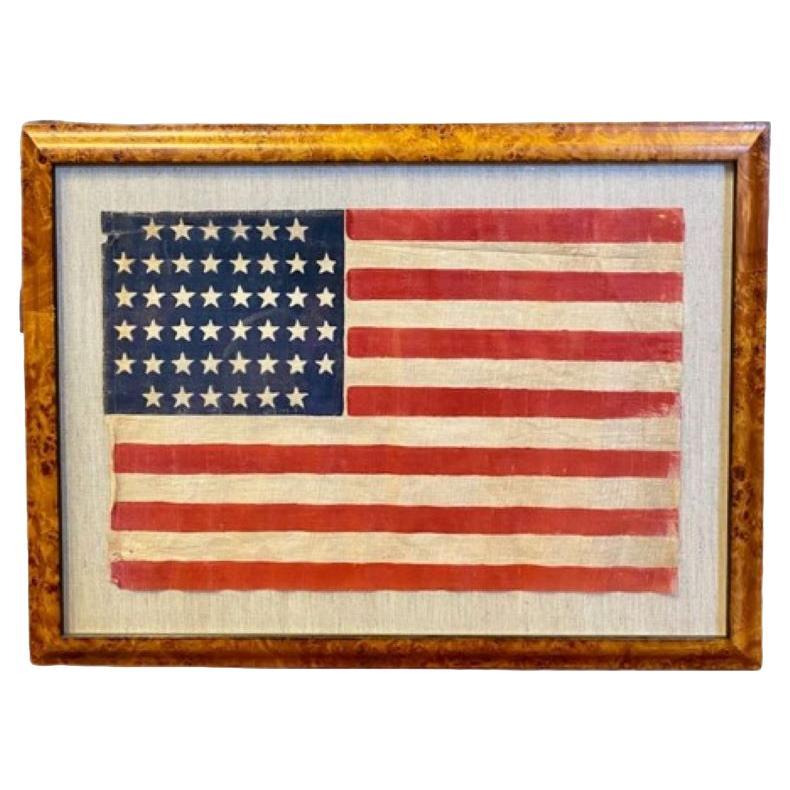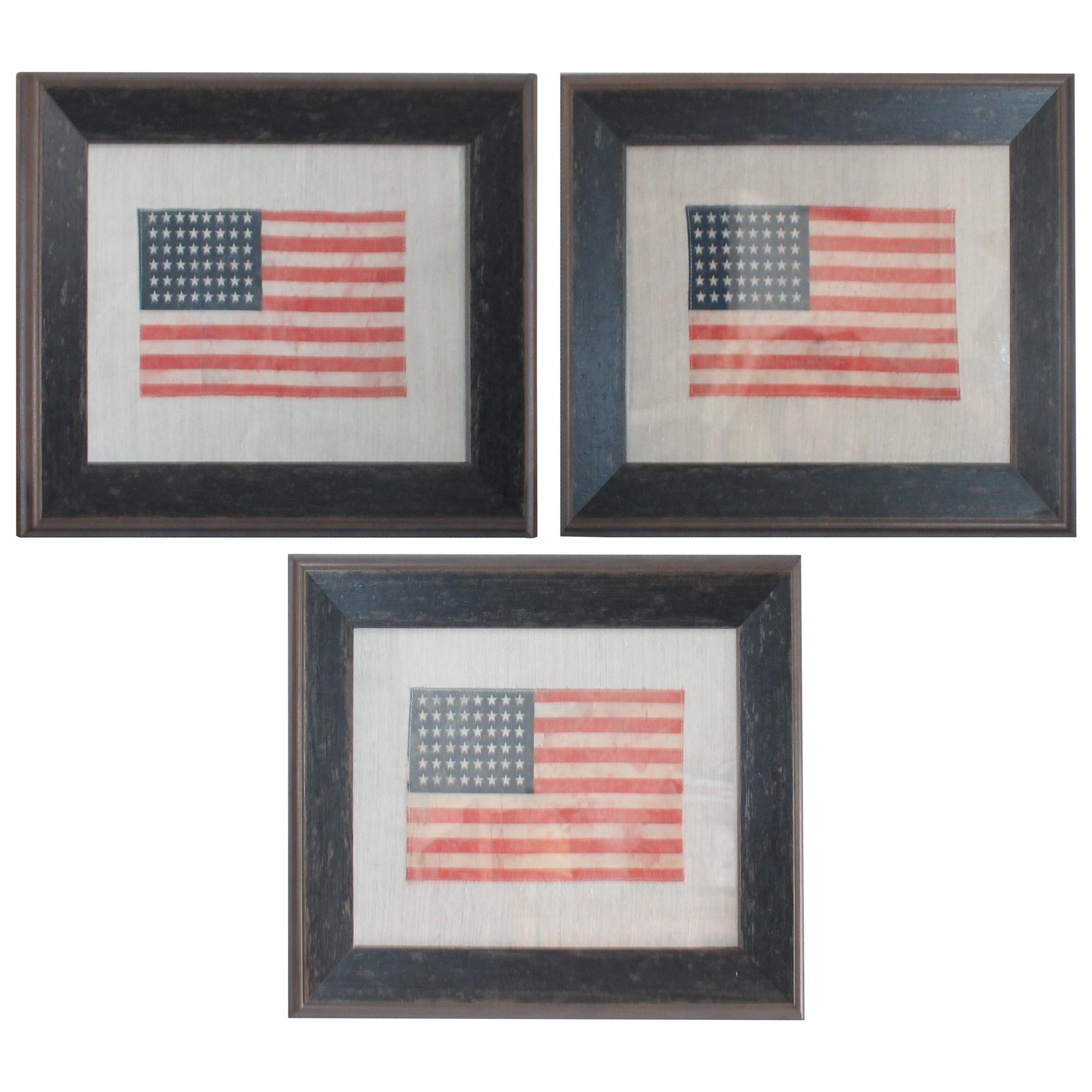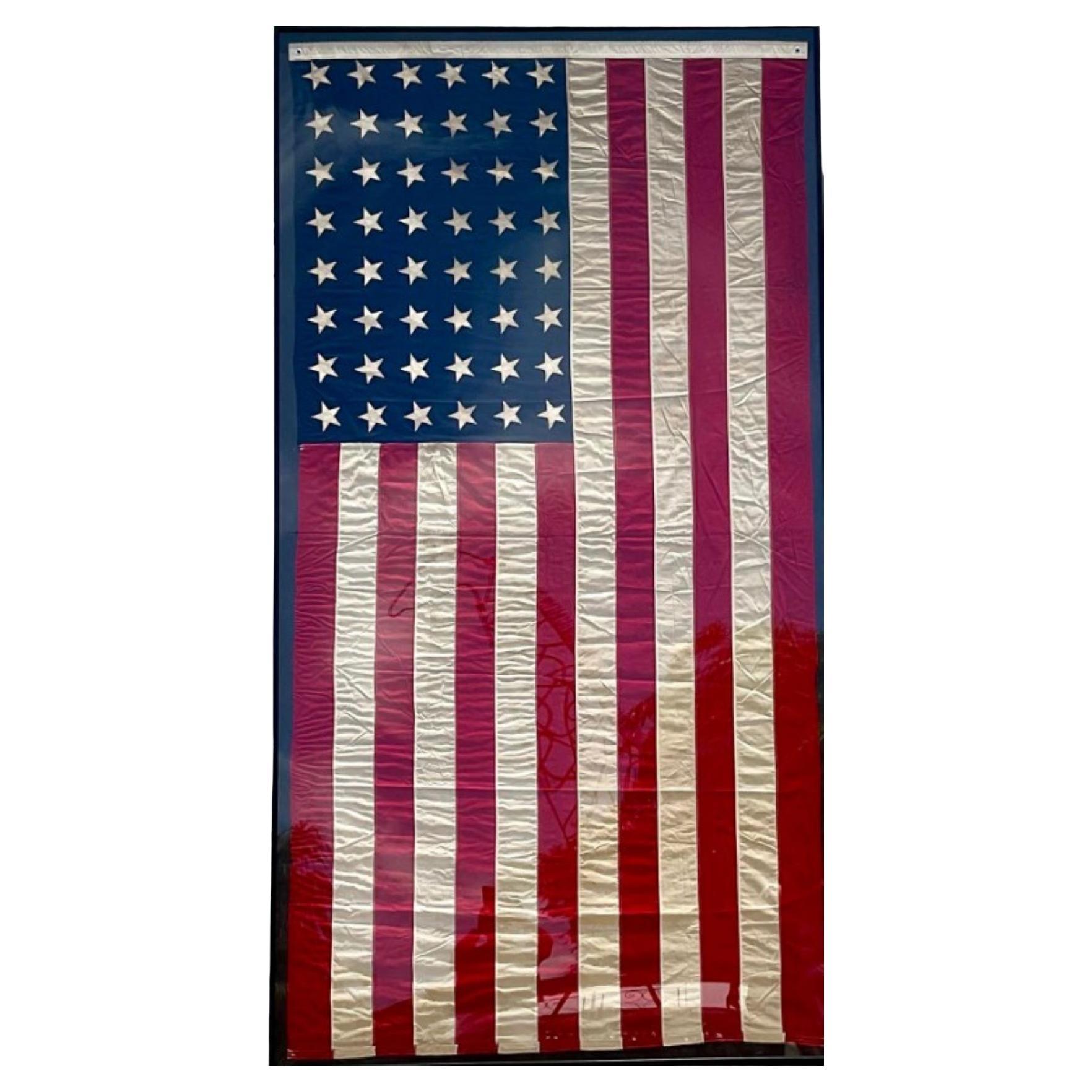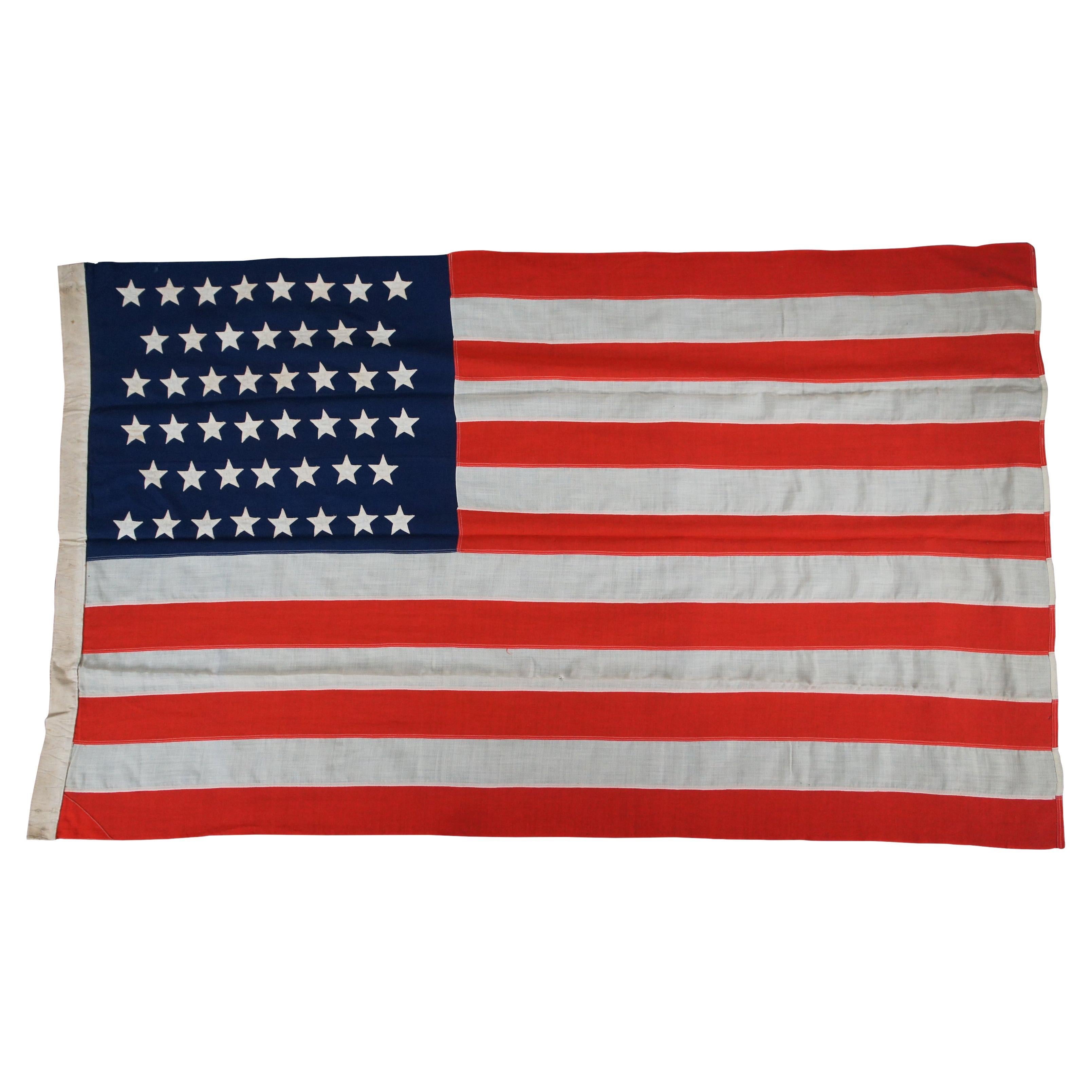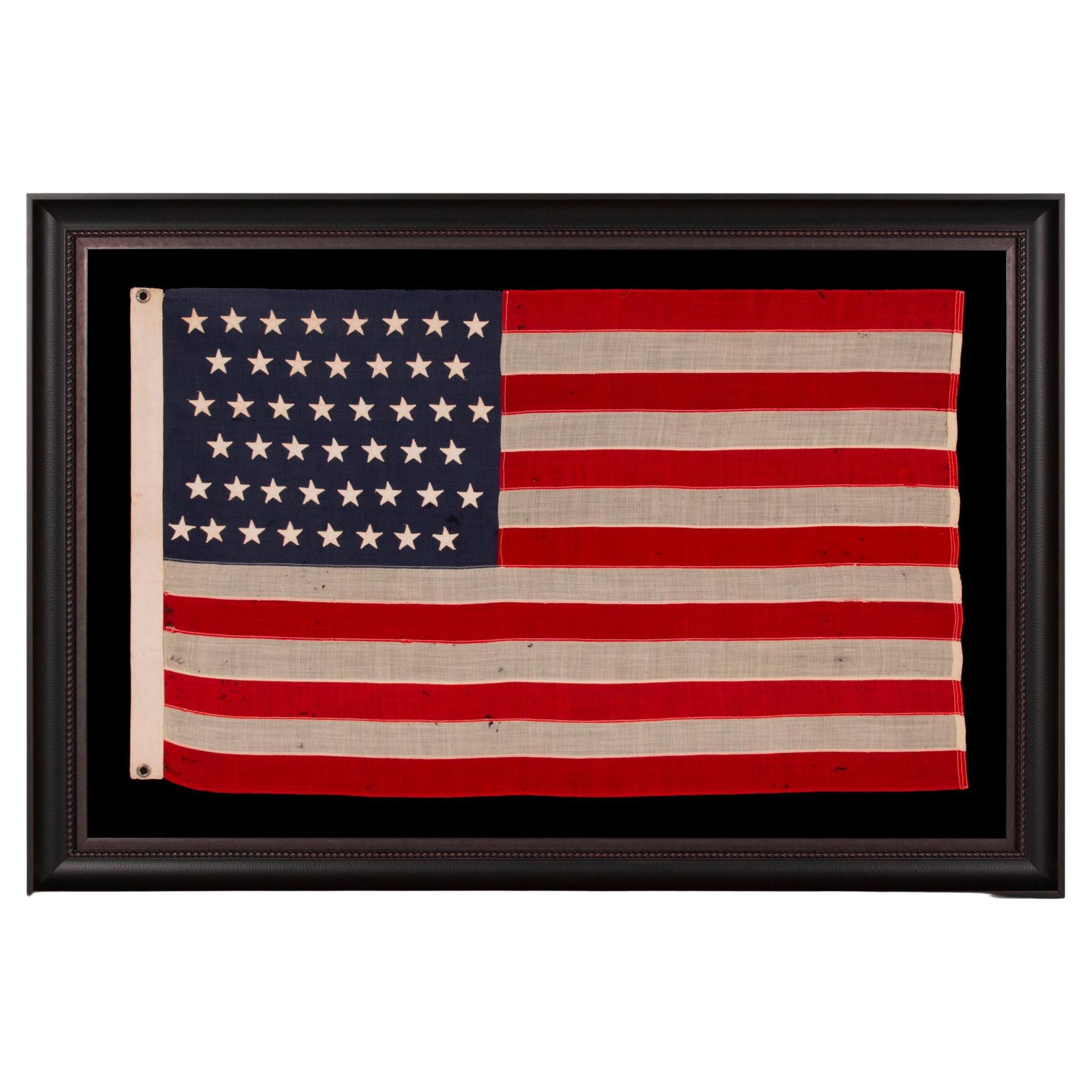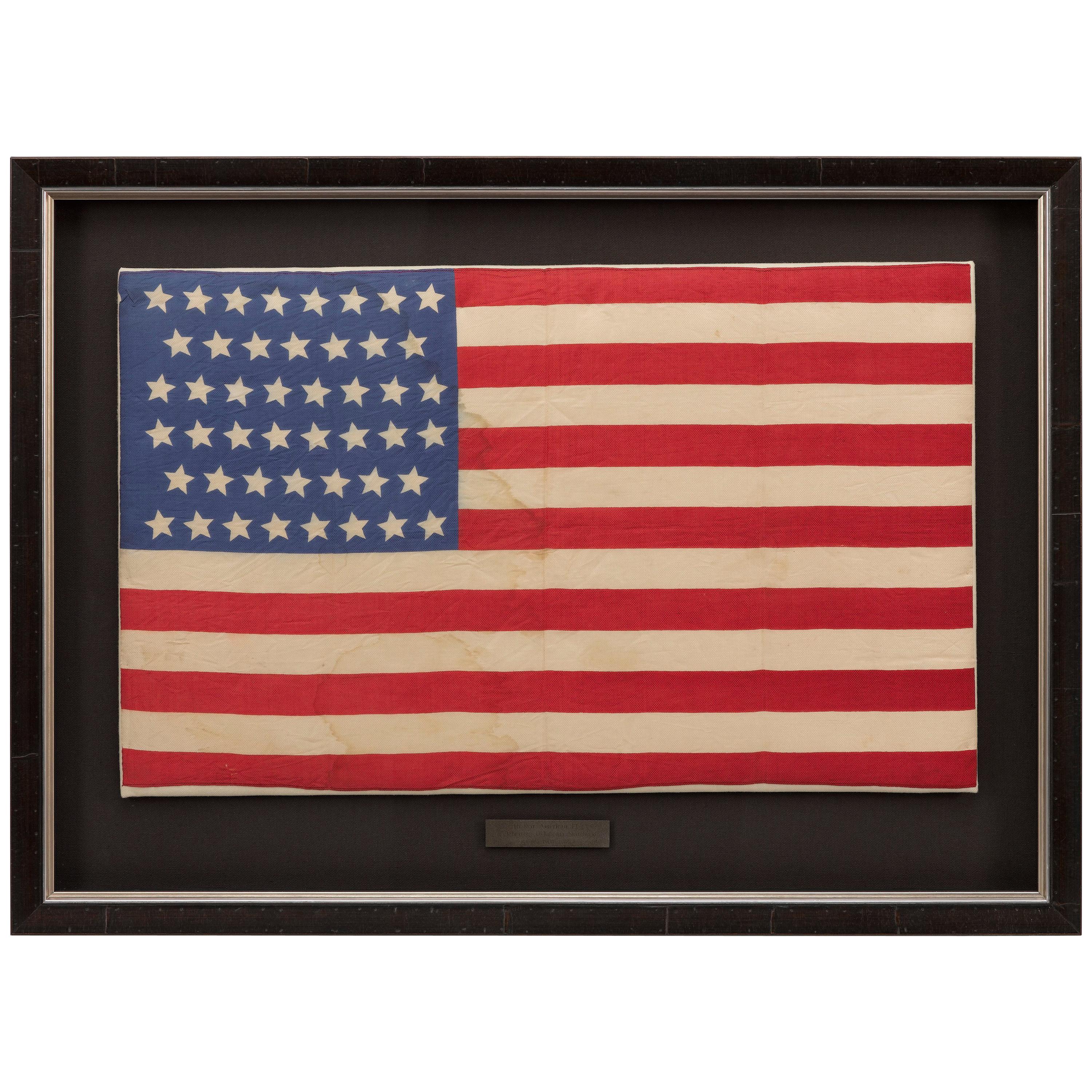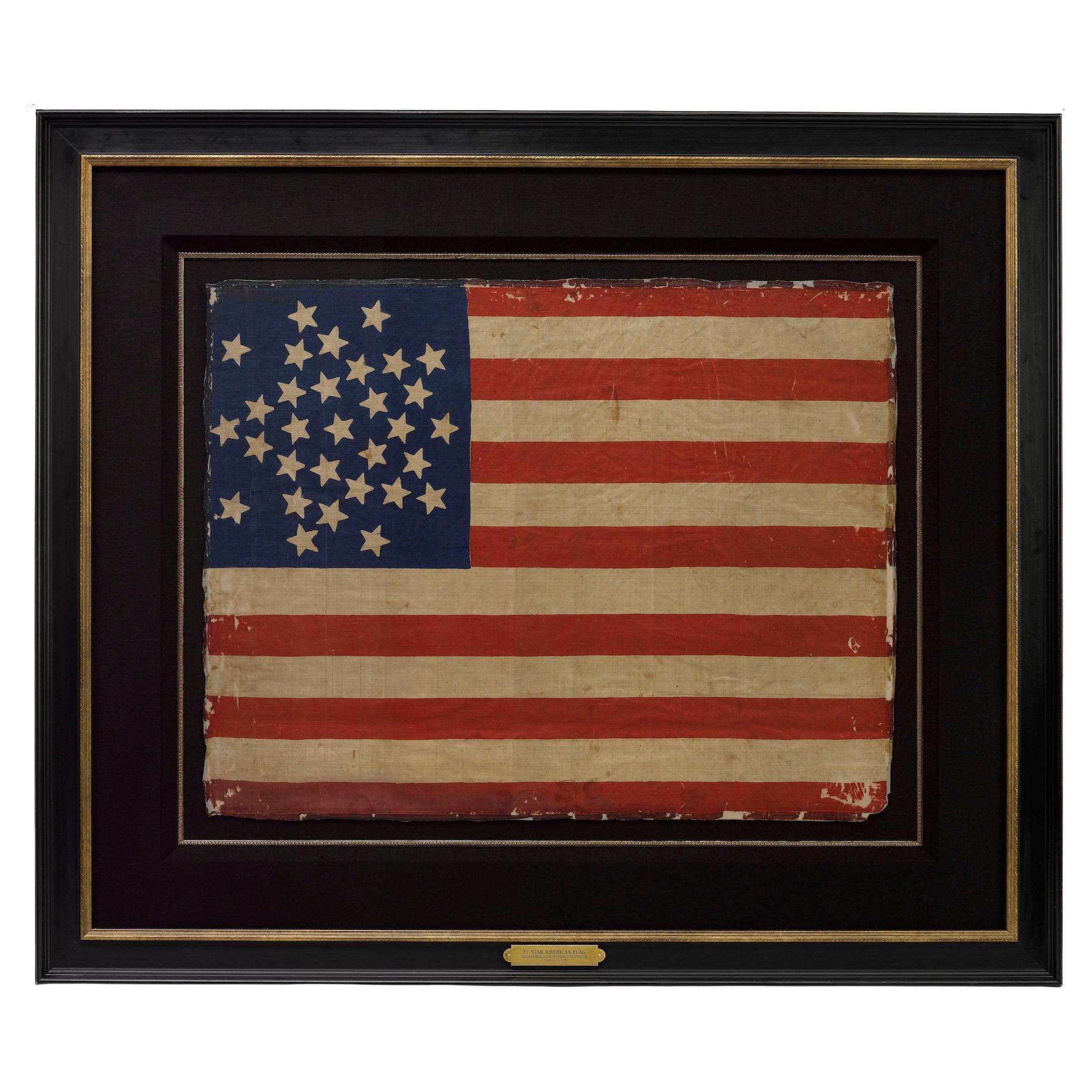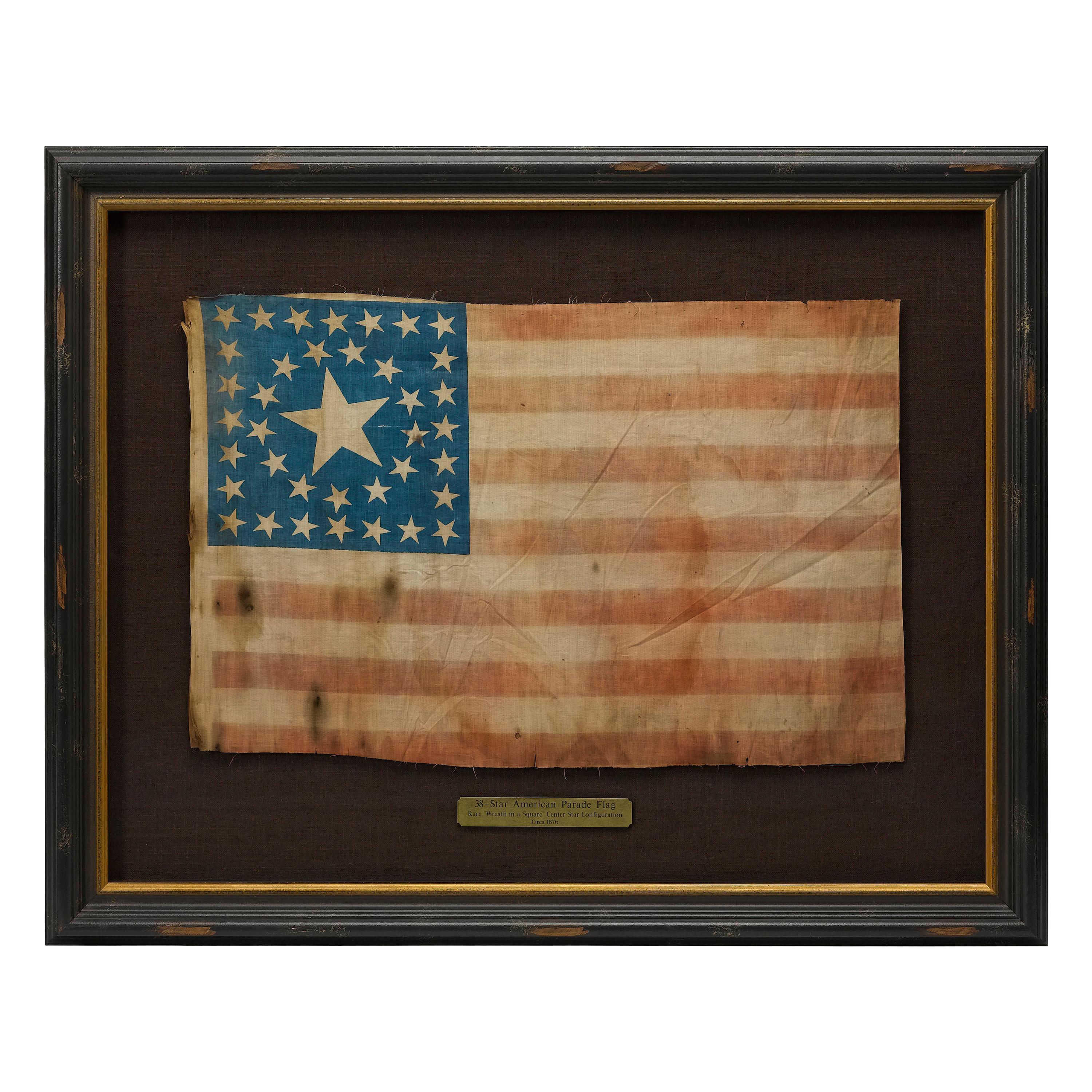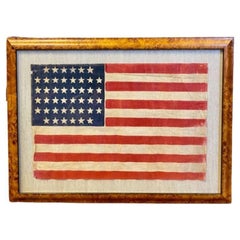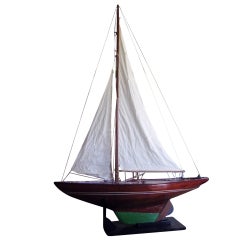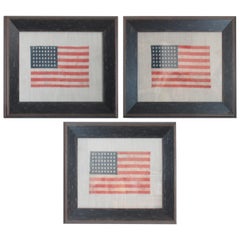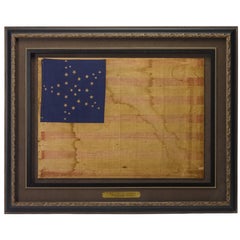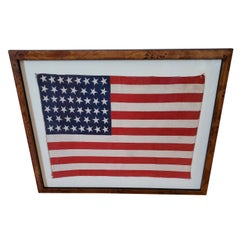
American 46 Star Linen Flag, circa 1908
View Similar Items
Want more images or videos?
Request additional images or videos from the seller
1 of 6
American 46 Star Linen Flag, circa 1908
About the Item
- Dimensions:Height: 16.63 in (42.25 cm)Width: 20.88 in (53.04 cm)Depth: 0.88 in (2.24 cm)
- Style:Other (Of the Period)
- Materials and Techniques:
- Place of Origin:
- Period:1900-1909
- Date of Manufacture:circa 1908
- Condition:Wear consistent with age and use.
- Seller Location:Nantucket, MA
- Reference Number:Seller: AD - 263-98 WOY1stDibs: LU903927465032
About the Seller
5.0
Gold Seller
These expertly vetted sellers are highly rated and consistently exceed customer expectations.
1stDibs seller since 2010
243 sales on 1stDibs
Typical response time: 1 hour
More From This SellerView All
- American 44 Star Flag, circa 1891Located in Nantucket, MARare Antique American 44 Star Flag, circa 1891, marking admission of Wyoming as a state in 1891. This was an official flag of the United States for only five years, making it one of ...Category
Antique 1890s American Federal Historical Memorabilia
MaterialsMuslin
- American Darting Gun Toggle Iron Harpoon, Marked Macy, for Bark SunbeamLocated in Nantucket, MAAntique American Darting Gun Toggle Iron Harpoon, made by E.B. and F. Macy, New Bedford, for the Larboard Boat on the Whaling Bark Sunbeam (1856 - 1908), having an improved toggle head with acute barb (standing nearly at a right angle), and an unusual ridged cheek, with the maker's mark MACY stamped on the right cheek (the mark of E.B. & F. Macy, blacksmiths of New Bedford: 1861-1904), the ship stamp BK SB on the left cheek (for the Bark Sunbeam, and the dot punched boat mark L B (for the Larboard, or Second, or Port-side Stern whale boat); mounted on a round shank slightly kinked from use, ending in the spike end necessary for use with a darting gun, and the loop for splicing on the iron strap. An amazing artifact retaining a tremendous amount of historical documentation. The harpoon remain in very good condition with a still very sharp cutting edge and deep brown patina and no corrosion. The head is frozen, but in the absence of rust it would very likely free up with a little lubrication if so desired. The tip of the front barb has a small chip off tip. The slight kink to the shank comes from use and is considered by most to be a a good feature. The Bark SUNBEAM was built in Mattapoisett in 1856 and enjoyed a long career in the New Bedford whale fishery of 17 voyages to the Pacific, Atlantic and Indian Oceans. Clifford Ashley...Category
Antique 1860s American Other Nautical Objects
MaterialsSteel
- Antique American Pond ModelLocated in Nantucket, MAAntique American Marconi-rigged sloop Pond model with planked deck, double spreaders and full running rigging.Category
Early 20th Century American Models and Miniatures
MaterialsBrass
- Seascape with Clippership by George Howell Gay (American: 1858 - 1931), ca 1890Located in Nantucket, MASeascape with Clippership by George Howell Gay (American: 1858 - 1931), circa 1890, an oil on canvas bow view of a clippership under full sail, running with stun'sls and skysails set, on lively sea under blue cloudy sky, with a second square-rigger visible in the background, signed in the lower right, and titled on the reverse "Clipper Ship Before the Wind." A beautiful and dramatic painting with a cool, brisk feel. The painting is in fine condition, with one small patch along the upper margin and a tiny spot of corresponding inpainting. Measures:24 in H x 20 in W Framed: 29 in H x 25 in W George Howell Gay was born in Milwaukee, Wisconsin, and educated in Chicago under Paul Brown and Henry Elkins, and in 1889 moved to Bronxville, New York. He worked in all media, but was especially fond of watercolor, which allowed him to capture the transparency of the ocean and the luminous qualities of sunlight and clouds. Gay worked along the Northeastern coast from Rhode Island to Maine, but also painted summer and winter landscapes throughout New England. Gay’s seascapes were exhibited at the Boston Art...Category
Antique 1890s American Other Paintings
MaterialsCanvas
- Nantucket Opera House Menu, circa 1960s to 1970sLocated in Nantucket, MARare Vintage Menu from the Opera House Restaurant on Nantucket, circa 1960s. The beloved and fondly missed Opera House was the iconic restaurant owned and operated by Gwen Gaillard o...Category
Vintage 1960s American Other Historical Memorabilia
MaterialsPaper
- Grand Banks Dory Fishermen Seascape by Joseph Woods, circa 1910Located in Nantucket, MAAntique grand banks dory fishermen seascape by Joseph A. Woods, circa 1910, an impressionist oil on panel seascape with two fishermen in dory in the foreground hauling back on their ...Category
Vintage 1910s American Other Paintings
MaterialsWood
You May Also Like
- 46-Star American Flag Printed in Drum Star ConfigurationLocated in Colorado Springs, COThis is an original 46-Star American parade flag, celebrating Oklahoma statehood. Each star on the flag's canton represents a state in the Union at the time. The official flag design would update every July 4th, to include any new states added to the Union in the past year. Oklahoma, the 46th state, entered the Union on November 16, 1907. As such, this 46–star flag was the official flag of the United States from July 4, 1908, until July 4, 1912. The silk flag has a dark blue canton with 46 white printed stars. The stars are printed in an 7-8-8-8-8-7 row configuration, or “Drum design.” The flag design is completed with 13 alternating red and white stripes, each stripe representing one of the original thirteen colonies. The land that comprises Oklahoma today was added to the United States as part of the Louisiana Purchase of 1803. Throughout the 19th century, the U.S. government relocated Indian tribes from the southeastern United States to the area, and by 1900, over 30 Indian tribes had been moved to what was originally called the Indian Territories. At the same time, ranchers in Texas began to move into the area in search of new pasture lands. Although stipulations in the Indian Relocation Act agreed that the land would forever be Indian Territory, the promise of fertile farmland trumped the government’s promise of sovereignty. On April 22, 1889, they opened the land to settlement by homesteaders, creating a land run in which settlers, called “Boomers,” were allowed to cross the Texas or Arkansas border at a particular hour to claim homesteads. Settlers who illegally crossed the border earlier to stake prime land were called “sooners,” which eventually became the state’s nickname. Wagons and the Santa Fe railroad carried cartloads of men and women to blank town sites and building plots, creating ten thousand-people communities in a matter of days. The following year, the region was further divided into Indian Territory and Oklahoma Territory...Category
Vintage 1910s American Political and Patriotic Memorabilia
MaterialsSilk
- 48 Star Oil Cloth Flag on Linen BackingLocated in Los Angeles, CA48 star flag is made from a vintage oil cloth sewn on vintage linen. The frame is a custom made frame on each. Each Measures 14 x 17.5. If anyone would li...Category
Early 20th Century American Other Historical Memorabilia
MaterialsLinen, Wood
$716 Sale Price20% Off - 34-Star Civil War American Flag, Antique Great Star Pattern, circa 1861Located in Colorado Springs, COThe stars of this extremely rare, Civil War-era flag are arranged in what is sometimes called the "Great Flower" pattern, a large star made out of smaller stars -- named as such beca...Category
Antique 1860s American Political and Patriotic Memorabilia
MaterialsLinen
$15,500 Sale Price37% Off - Antique 46 Star WMH Horstmann Company United States of America Flag 83"By HorstmannLocated in Dayton, OHAntique forty six star large wool American flag by Horstmann Company, circa 1908-1912. Horstmann firm was founded by William H. Horstmann (1785-1850), who had immigrated to Philadelphia from Germany. Horstmann bought out a local swordmaker in 1828 and thereafter entered the military goods field. The firm benefitted from the Civil War, becoming the largest military goods supplier in the nation by 1864. WILLIAM H. HORSTMANN & SONS, Manufacturers of Dress Trimmings and Military Goods. 5th & Cherry Streets, Philadelphia, PA. This house was founded, in 1815, by William H. Horstmann, a native of Cassel, in Germany. He had learned the trade of silk-weaving in France, and, emigrating to the United States in the above-mentioned year, established himself in Philadelphia as a manufacturer of fringe, laces and trimmings of various kinds. He married the daughter of Frederick Hoeckly, a German settler in Philadelphia, and also a manufacturer of fringe, coach-lace and tassels. He devised several improvements in this trade, especially by introducing varieties in the styles and patterns of this class of goods, there being at that time only two patterns used in the trade, which were known as the Jefferson pattern and the Monroe pattern. In 1824, he introduced into this country from Germany the use of plaiting or braiding machines, and about the same time he was the first to introduce into this country the use of the Jacquard loom, for weaving patterns in textile fabrics. His location was in the first instance at No. 50 North Third street, but within a short time he removed to a store next to the Harp and Crown tavern, afterwards known as the City hotel, and continued his business within a short distance of this point for many years. In 1828, he commenced the manufacture of military trimmings as a special department, and this branch has grown to most important proportions, Horstmann's military goods being in demand throughout time country. The firm have also executed large Government contracts in this line for the War and Navy Departments. In 1831, he established a branch house in New York city, and about the same time erected a factory at the corner of Germantown road and Columbia avenue. The factory was continued here until time erection of the extensive building at Fifth and Cherry streets, where the works, salesrooms and offices of time firm now are. This massive structure is six stories high, and extends 140 feet on Fifth street and 200 on Cherry street, and reaches back to Race street. The separate departments into which the business is divided are thirty in number. More than 1000 distinct looms and machines are in use in the building, many of them very costly and some invented and used exclusively by this firm, the motive power being supplied by a steam engine of fifty horse power. The area covered by the works is about 11,000 square feet. Time number of hands employed is very large, about 500. When the erection of a vast factory at this point was first proposed, a strong opposition was made by time holders of the neighboring property. The ancient German Lutheran Church and burying ground, since removed, stood opposite the site, and a bill was introduced into the Legislature to forbid the use of a steam engine within 100 yards of any place of worship. The interests which such a bill would have affected injuriously, especially those of several newspapers, roused a strong opposition to it, and it failed to become a law. In 1845, William H. Horstmann, the founder of the house, retired from the business, and his two sons, William and Sigmund, assumed the management and it was under their direction that the new building, above described, was erected. The goods produced by this house are of almost endless extent and variety. They include goods woven from all the various textile fibres—cotton, wool, silk, etc.—in every style, color and pattern, and are used for an infinite number of purposes. Narrow woven goods are time staple production, made up into material for dresses for both sexes, for use in daily life, and for regalia for ""societies;"" for the costumes of the stage, the upholstering of houses and of carriages, the uniforms of soldiers, together with equipments for the same, and for funeral purposes. The raw material used in the manufacture is to a great extent very costly, and their store rooms often hold as much as $200,000 worth of goods in an unworked state. There are two rooms devoted to power looms in the factory, one for coach lace and one for other styles of weaving, in which about 250 of these machines are constantly running. The braiding machines in the coach lace room are very noteworthy. The cord to be covered with braid is drawn through an opening in time middle of a flat, circular, metallic plate, about 15 inches across. Up to a point on this cord, about a foot above the plate, the threads of the braiding material converge, like the ribs of a tent-roof, and there weave in and out and out and in, as the coating of braid grows, and time covered cord rises and is wound away above. The weaving is accomplished by the motion of the spools below that carry the different threads of the braid. These spools stand in uprights, which are carried round and amongst each other in curved slots in the above-mentioned broad metallic plate. All but two of these spools run in and out among each other, with a swift, easy and intricate motion, mind so rapid that time eye can hardly follow it, while one or two special spools run steadily round and round among time twisting spools with the most extreme swiftness. Many other machines, displaying equally ingenious mechanism, are used in the factory. The various details of equipment manufactured and supplied by this house are also important, both for their number and the superior quality of the manufacture. The one article of swords may be taken as an instance. This trade grew naturally and immediately out of the established army and navy goods department of the works, it being necessary that the sword itself should be furnished together with the sword-belt and other trappings all complete. Every part of the sword and trappings, with the exception of the blade, is made on the premises. The blades are almost all imported from the ancient German sword-blade emporium of Solingen, where, it is said, swords have been made ever since the year 1147, when Count Adolphus of Berg brought home from the East and established there the business of forging Damascus blades. There is in this department a stock of some thousands of blades, of many different patterns and sizes, ready to be set and finished. Any style or sword can be had from this warehouse, from the plainest kind up to a presentation sword...Category
Vintage 1910s American Classical Political and Patriotic Memorabilia
MaterialsWool
- 46 Star Antiques American Flag, Small Scale, Oklahoma Statehood, Ca 1907-1912Located in York County, PA46 star antique American flag in an exceptionally small scale among its pieced-and-sewn counterparts, reflects oklahoma statehood, circa 1907-1912: 46 star American national flag in a tiny and very rare scale among its counterparts of the period with pieced-and-sewn construction. The 46th state, Oklahoma, joined the Union on November 16th, 1907, during Teddy Roosevelt’s presidency. Roosevelt had many friends in the Oklahoma Territory...Category
Early 20th Century American Political and Patriotic Memorabilia
MaterialsWool
- 46-Star American Flag, Antique Printed on Silk, Early 20th CenturyLocated in Colorado Springs, COThis is an original 46-star American parade flag, printed on silk. Each star represents a state in the Union at the time. The official flag design would update every July 4th, to inc...Category
Antique Early 1900s American Political and Patriotic Memorabilia
MaterialsSilk
Recently Viewed
View AllMore Ways To Browse
Antique Tiger Maple Furniture
Antique Tiger Maple
Oklahoma Flag
Tiger Maple Frame
46 Star Flag
Antique Indian Flag
Antique Flag Pin
Star Tiger
Antique American Flag Pin
Liberty Brass
Antique Oregon
Antique British Military
Vintage German Christmas
Apollo Space
Christmas German
British Coat Of Arms
Antique And Vintage Woods Of America
Authentic Flags

